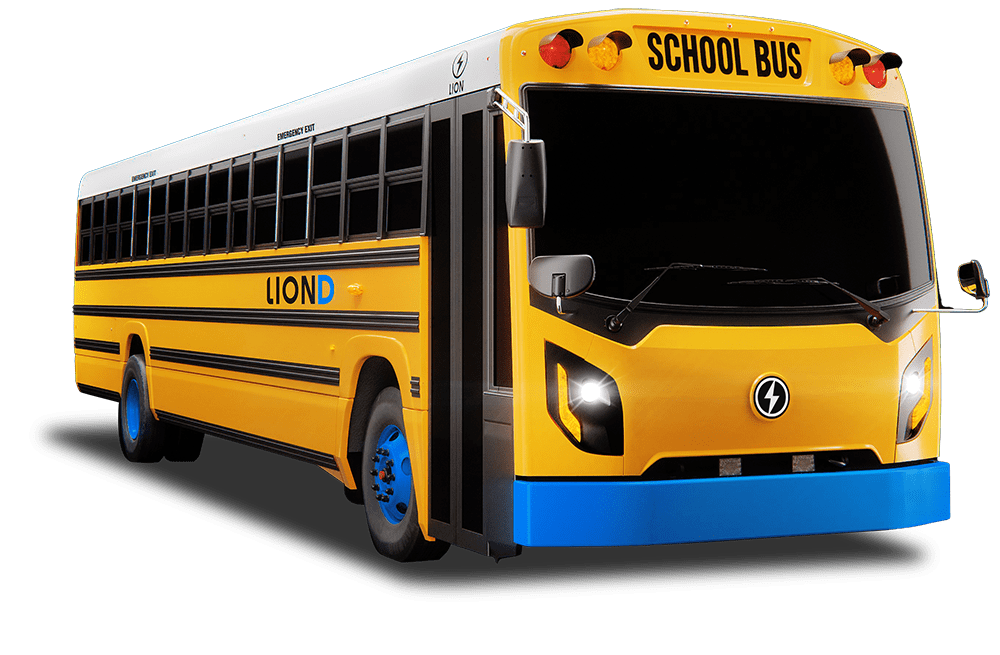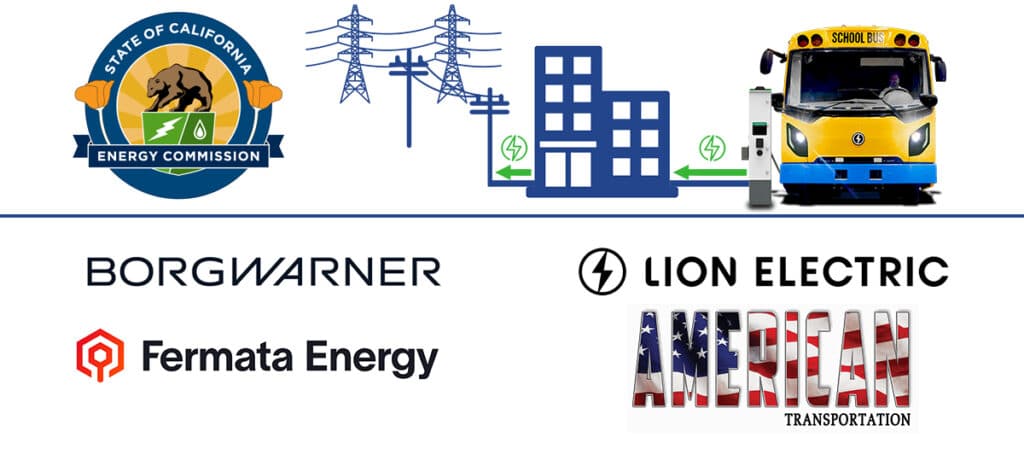CEC Awards $3M to BorgWarner, Fermata Energy, Lion Electric for Innovative V2G Project
The California Energy Commission (CEC) has taken a monumental stride toward sustainable energy and transportation by awarding BorgWarner Inc., alongside project partners Fermata Energy and The Lion Electric Company (“Lion Electric“), a $3 million grant dedicated to an innovative Vehicle-to-Grid (V2G) project. This groundbreaking initiative aims to introduce grid-supporting and cost-saving V2G solutions to services provided by American Transportation for California school districts. By facilitating the integration of electric school buses into the energy grid, this project not only represents a significant leap in energy management practices but also underscores the transition towards more sustainable, electrically powered school transportation. Through this effort, the partners anticipate not only to enhance the operational efficiency of school buses but also to contribute significantly to the reduction of carbon emissions, aligning with California’s ambitious environmental and sustainability goals.

In recent years, California has been at the forefront of grappling with the impacts of climate change, as evidenced by an uptick in extreme weather phenomena such as protracted heatwaves, enduring droughts, and devastating wildfires. These events have significantly increased the demand on the state’s energy grid, highlighting the urgent need for innovative solutions to bolster grid resilience and sustainability. The integration of more electric vehicles (EVs) onto the market presents a unique opportunity to leverage Vehicle-to-Grid (V2G) technology as a pivotal component of California’s clean energy strategy. By harnessing excess power generated from renewable sources, like solar and wind, during peak production times and utilizing it for charging EVs during heightened demand periods, V2G technology can mitigate strain on the grid. Collaboratively, BorgWarner, Fermata Energy, and Lion Electric, in partnership with the California Energy Commission (CEC), are spearheading the adoption of AI-driven V2G technology. This initiative couples a fleet of electric school buses with cutting-edge technology aimed at empowering the buses’ batteries to furnish the grid with supplementary power during emergencies while parked. Additionally, this venture opens avenues for generating income through demand response programs and other financial mechanisms, substantially reducing the Total Cost of Ownership (TCO) of these vehicles.
According to the California Energy Commission’s (CEC) grant-funded opportunity, named Electric School Bus Bi-Directional Infrastructure (GFO 22-612), the implementation of electric school buses equipped with bidirectional charging capabilities stands as a strategic measure to mitigate the effects of grid reliability issues and Public Safety Power Shutoff (PSPS) events. Notably, several California school districts are already operating electric school buses that possess the potential to harness Vehicle-to-Grid integration (VGI) benefits. This development presages a trend towards a broader adoption across the state, with expectations for a significant increase in electric school bus orders in the near future. Underpinning this initiative is the CEC’s Clean Transportation Program, which facilitates the installation of 21 BorgWarner 125 kW UL-listed, combined charging system (CCS) protocol bidirectionally-enabled chargers. These chargers will be paired with a minimum of 20 LionD all-electric school buses. To maximize the financial and grid benefits for the school districts, Fermata Energy’s Vehicle-to-Everything (V2X) software platform will undertake the management of charging and discharging processes of these buses. This arrangement not only enhances grid resilience but also opens up avenues for generating V2X revenue for the participating school districts.
The deployment of Vehicle-to-Grid (V2G) technology for the Conejo Valley Unified School District (CVUSD) and the Los Angeles County Office of Education (LACOE), in collaboration with American Transportation, the school bus fleet operator servicing these districts, marks a significant step towards improving grid reliability. By utilizing the bidirectional charging capabilities of electric school buses, these entities can help stabilize the power grid during Public Safety Power Shutoff (PSPS) events and extreme weather conditions. Beyond enhancing grid resilience, this initiative underscores the dual benefits of fostering environmental sustainability and public health. Zero-emission electric school buses powered by V2G technology significantly reduce the exposure of students and communities to harmful pollutants compared to traditional diesel-powered buses. Additionally, by selling excess power back to the grid, the CVUSD, LACOE, and American Transportation can generate revenue, creating a financially viable model that combines economic efficiency with ecological stewardship. This pioneering approach not only sets a precedent for other districts but also exemplifies the versatile advantages of integrating V2G technology into school transportation systems.

“This CEC grant and project underscores the power of partnerships and our collective dedication to sustainability as we deploy this cutting-edge V2G bidirectional hardware and software solution,” said Tony Posawatz, CEO of Fermata Energy. “Together, we are advancing electric vehicle integration and grid support in California schools while enabling a viable path toward renewable energy for future generations.”
“American Transportation strives to be at the forefront of technology and innovation in an industry that often struggles to break free from its antiquated means of operation. With the assistance of the CEC grant and the company’s strong partnerships formed with BorgWarner, Fermata Energy, and Lion Electric, we are able to provide a glimpse into the future of safe, clean, and environmentally sustainable student transportation. This is an exciting time to witness a pivotal change in the industry and we are extremely grateful to play a role in that advancement,” commented Dan Wilson, CEO of American Transportation.
Fermata Energy’s AI-driven Vehicle-to-Everything (V2X) software platform represents a groundbreaking advance in the optimization of energy management systems for electric vehicles (EVs). By analyzing thousands of rapidly changing data points, the software facilitates informed decisions regarding when and how EVs should charge or discharge. This capability not only benefits EV owners and operators by unlocking opportunities for participation in grid-support programs, which can lead to significant revenue or savings, but it also plays a critical role in enhancing grid stability. Fermata Energy’s technology provides precise signals to both the V2G Electric Vehicle Supply Equipment (EVSE) and the connected EVs, dictating optimal times for charging and discharging actions to maximize value for both the vehicle owners and the grid at large. With a track record of successful implementations across the United States, Fermata Energy demonstrates the tangible benefits of integrating intelligent software solutions with electric vehicle infrastructure to support the evolving needs of the electrical grid.
“With this new technology, electric school buses are not only delivering cleaner air to our children and cost savings to our school districts, but also providing extra power to the grid when we need it most,” said Patty Monahan, California Energy Commission’s Lead Commissioner for Transportation.
The California Energy Commission (CEC)’s electrification goals receive a significant boost with the implementation of V2X bidirectional school bus technologies, exemplifying how targeted innovations can meet environmental standards while also benefiting the financial bottom line of educational institutions. Through the utilization of electric school buses equipped with V2X technology, school districts not only transition towards cleaner, more sustainable transportation options but also unlock a novel revenue stream or enjoy substantial electric bill savings. This is made possible as these buses serve a dual purpose; they transport students safely while also acting as mobile energy storage units that can supply the electrical grid during periods of high demand or when renewable energy sources are scarce. The CEC’s grant for large-scale demonstrations illustrates the multifaceted value electric school buses bring to the grid when parked, positioning them as powerful tools in the broader national effort towards grid resilience and sustainability. This initiative paves the way for schools across the United States to adopt similar models, merging educational transportation needs with broader ecological and financial objectives.
“BorgWarner is proud to partner with Fermata Energy and Lion Electric on this exciting project, supporting the State of California in electrifying the transportation departments of their school districts while addressing real grid challenges,” said Isabelle McKenzie, Vice President of BorgWarner Inc. and President and GM, Morse Systems. BorgWarner’s bidirectionally-enabled chargers, combined with Fermata’s software and Lion Electric’s energy storage solutions, is a real-world case study in the V2G business case and we are excited to get started.”
“The investment from the CEC for V2G-dedicated projects is a testament to the significance of this emerging technology and how collaborating with Fermata Energy and BorgWarner is helping address the demands of electrification,” said Nate Baguio, Senior Vice President of Commercial Development at Lion Electric. “We have been at the forefront of shaping the V2G business case for several years in California and the United States, and these partnerships are vital for the future of clean energy transportation.”
While California is at the forefront of adopting electric school buses, a relatively small number of districts with these electric fleets are presently utilizing bidirectional charging systems that enable both mobility and ancillary energy services. In an effort to harness the full potential of this technology, the state is entering into partnerships with key industry players such as BorgWarner, Fermata Energy, and Lion Electric. These collaborations aim to deploy bidirectional charging infrastructure that not only supports grid reliability but also offers a resilient response to Public Safety Power Shutoff (PSPS) events and wildfires. Furthermore, these advanced charging systems are designed to provide additional resources during peak electricity demand, either on the grid or directly at customer sites. This strategic move underscores California’s commitment to not just pioneering in the electrification of school transportation but also in leveraging this infrastructure for broader grid stability and sustainability goals.
“The Conejo Valley Unified School District is proud to partner with American Transportation as an early adopter of electric buses, which will soon join the fleet of vehicles the CVUSD uses to transport our scholars to school and to extracurricular activities,” said Dr. Victor Hayek, Conejo Valley Unified School District’s Deputy Superintendent. “This new sustainable technology will support this endeavor, with positive infrastructure and environmental impacts for our community – a big win-win.”

